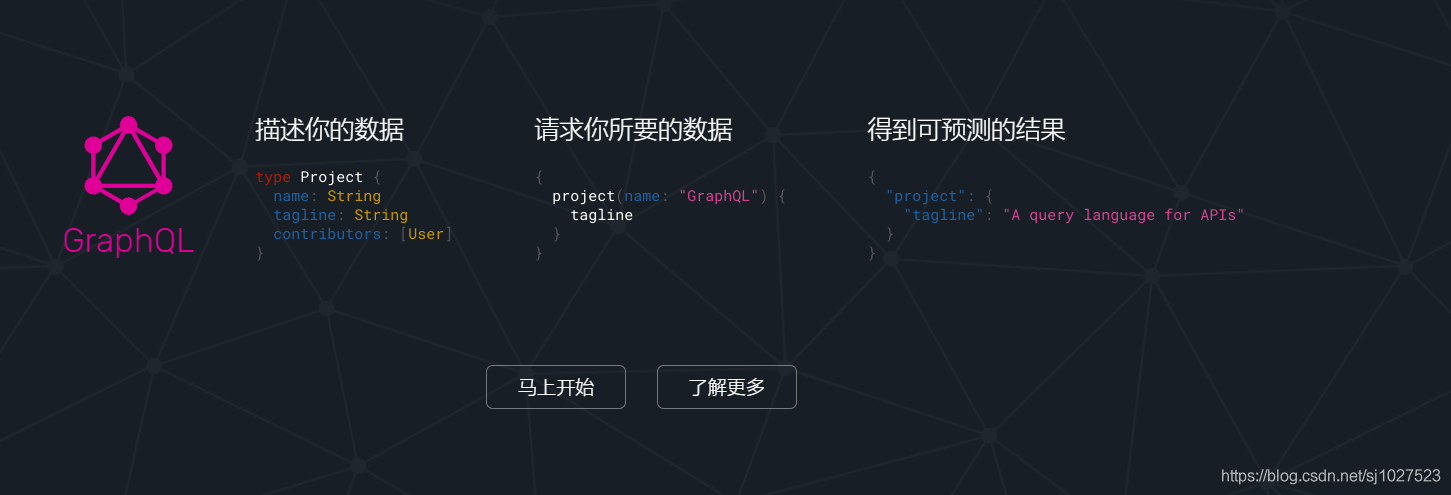GraphQL的基本使用
GraphQL定义
graphql是由Facebook创造的用于描述复杂数据模型的一种查询语言。这里查询语言所指的并不是常规意义上的类似sql语句的查询语言,而是一种用于前后端数据查询方式的规范。
官网中文:https://graphql.cn/
规范地址::http://spec.graphql.cn/

RESTful问题
RESTful是我们已经很熟悉的用于api通信的规范,如这样:
GET http://127.0.0.1/user/1 #查询 POST
http://127.0.0.1/user #新增 PUT
http://127.0.0.1/user #更新 DELETE
http://127.0.0.1/user #删除
在查询的时候,往往是这样:
#请求 GET http://127.0.0.1/user/1001
#响应:
{
id : 1001,
name : "张三",
age : 20,
address : "北京市",
……
}
这样似乎是没有问题的,如果,对于这次请求,我只需要id和name属性,其他的属性我都不需要,如果我依然拿
到的是全部的属性,这是不是一种资源浪费?
还有这样的一种场景,就是一次请求不能满足需求,需要有多次请求才能完成,像这样:
#查询用户信息
GET http://127.0.0.1/user/1001
#响应:
{
id : 1001, name : "张三",
age : 20,
address : "北京市",
……
}
#查询用户的身份证信息
GET http://127.0.0.1/card/8888
#响应:
{
id : 8888,
name : "张三",
cardNumber : "999999999999999", address :"北京市",
……
}
查询用户以及他的身份证信息,需要进行2次查询才能够完成,这样对于前端等接口的使用方是很不友好的,试想
一下,如果查询信息有10个,是不是要发起10次请求才能完成?
了解GraphQL
GraphQL很好的解决了RESTful在使用过程中的不足,接下来,我们进一步了解下它。
按需索取数据
演示地址:http://graphql.cn/learn/schema/#type-system


可以看出,当请求中只有name属性时,响应结果中只包含name属性,如果请求中添加appearsIn属性,那么结果
中就会返回appearsIn的值。
查询多个数据

可以看到,一次请求,不仅查询到了hero数据,而且还查询到了friends数据。节省了网络请求次数。
API的演进无需划分版本
查看官网的动画演示:http://graphql.cn/


从这些图中可以看出,当API进行升级时,客户端可以不进行升级,可以等到后期一起升级,这样就大大减少了客
户端和服务端的耦合度。
GraphQL查询的规范
GraphQL定义了一套规范,用来描述语法定义,具体参考:
http://graphql.cn/learn/queries/
说明:仅仅是规范,并不是具体实现,需要各种语言进行实现。
下面我们会讲一些基本的规范,更多的规范查看:http://graphql.cn/learn/queries/
字段(Fields)
在GraphQL的查询中,请求结构中包含了所预期结果的结构,这个就是字段。并且响应的结构和请求结构基本一致,这是GraphQL的一个特性,这样就可以让请求发起者很清楚的知道自己想要什么。

参数(Arguments)
在查询数据时,离不开传递参数,在GraphQL的查询中,也是可以传递参数的,语法:(参数名:参数值)

别名(Aliases)
如果一次查询多个相同对象,但是值不同,这个时候就需要起别名了,否则json的语法就不能通过了。
比如这样:

片段(Fragments)
查询对的属相如果相同,可以采用片段的方式进行简化定义。

GraphQL的Schema 和类型规范
Schema 是用于定义数据结构的,比如说,User对象中有哪些属性,对象与对象之间是什么关系等
参考官网文档:http://graphql.cn/learn/schema/
Schema定义结构
schema { #定义查询
query: UserQuery
}
type UserQuery { #定义查询的类型
user(id:ID) : User #指定对象以及参数类型 }
type User { #定义对象
id:ID! # !表示该属性是非空项
name:String age:Int
}
标量类型(Scalar Types)
GraphQL规范中,默认定义了5种类型:
- Int :有符号 32 位整数。
- Float :有符号双精度浮点值。
- String :UTF‐8 字符序列。
- Boolean : true 或者 false 。
- ID :ID 标量类型表示一个唯一标识符,通常用以重新获取对象或者作为缓存中的键。
规范中定义的这5种类型,显然是不能满足需求的,所以在各种语言实现中,都有对类型进行了扩充,也就是
GraphQL支持自定义类型,比如在graphql-java实现中增加了:Long、Byte等。
枚举类型
枚举类型是一种特殊的标量,它限制在一个特殊的可选值集合内。
enum Episode { #定义枚举
NEWHOPE
EMPIRE
JEDI
}
type Human {
id: ID!
name: String!
appearsIn: [Episode]! #使用枚举类型
homePlanet: String
}
接口(interface)
跟许多类型系统一样,GraphQL 支持接口。一个接口是一个抽象类型,它包含某些字段,而对象类型必须包含这
些字段,才能算实现了这个接口。
例如,你可以用一个 Character 接口用以表示《星球大战》三部曲中的任何角色:
interface Character { #定义接口
id: ID!
name: String!
friends: [Character]
appearsIn: [Episode]!
}
#实现接口
type Human implements Character {
id: ID!
name: String!
friends: [Character]
appearsIn: [Episode]!
starships: [Starship]
totalCredits: Int
}
type Droid implements Character {
id: ID!
name: String!
friends: [Character]
appearsIn: [Episode]!
primaryFunction: String
}
GraphQL的Java实现
通过前面的讲解,我们对GraphQL有了解,官方只是定义了规范并没有做实现,就需要有第三方来进行实现了,关
于GraphQL的java实现有几种,我们选择使用官方推荐的实现:graphql-java,我们通过该实现就可以编写
GraphQL的服务端了。
官网:https://www.graphql-java.com/
github:https://github.com/graphql-java/graphql-java

在maven中先添加graphql的配置先。
<id>bintray</id>
<repositories>
<repository>
<id>bintray</id>
<url>http://dl.bintray.com/andimarek/graphql-java</url>
<releases>
<enabled>true</enabled>
</releases>
<snapshots>
<enabled>false</enabled>
</snapshots>
</repository>
</repositories>
<pluginRepositories>
<pluginRepository>
<id>bintray</id>
<url>http://dl.bintray.com/andimarek/graphql-java</url>
<releases>
<enabled>true</enabled>
</releases>
<snapshots>
<enabled>false</enabled>
</snapshots>
</pluginRepository>
</pluginRepositories>
</profiles>
<!-- activeProfiles
| List of profiles that are active for all builds.
|
<activeProfiles>
<activeProfile>alwaysActiveProfile</activeProfile>
<activeProfile>anotherAlwaysActiveProfile</activeProfile>
</activeProfiles>
-->
<activeProfiles>
<activeProfile>bintray</activeProfile>
</activeProfiles>
1. 导入依赖
<dependency>
<groupId>com.graphql-java</groupId>
<artifactId>graphql-java</artifactId>
<version>11.0</version>
</dependency>
<dependency>
<groupId>org.projectlombok</groupId>
<artifactId>lombok</artifactId>
</dependency>
<dependency>
<groupId>commons-io</groupId>
<artifactId>commons-io</artifactId>
<version>2.5</version>
</dependency>
2. 编写实体类
@Data
@AllArgsConstructor
@NoArgsConstructor
public class User {
private Long id;
private String name;
private Integer age;
private Card card;
private String cardNumber;
private Long userId;
public Card() {
}
public Card(String cardNumber, Long userId) {
this.cardNumber = cardNumber;
this.userId = userId;
}
public String getCardNumber() {
return cardNumber;
}
public void setCardNumber(String cardNumber) {
this.cardNumber = cardNumber;
}
public Long getUserId() {
return userId;
}
public void setUserId(Long userId) {
this.userId = userId;
}
3. dome的编写
public static void main(String[] args) {
/**
* type User { #定义对象}
*/
GraphQLObjectType userObjectType = newObject()
.name("User")
.field(newFieldDefinition().name("id").type(GraphQLLong))
.field(newFieldDefinition().name("name").type(GraphQLString))
.field(newFieldDefinition().name("age").type(GraphQLInt))
.build();
/**
* user : User #指定对象以及参数类型
*/
GraphQLFieldDefinition userFieldDefinition = newFieldDefinition()
.name("user")
.type(userObjectType)
.argument(newArgument().name("id").type(GraphQLLong).build())
.dataFetcher(environment -> {
Long id = environment.getArgument("id");
// 查询数据库了
// TODO 先模式实现
return new User(id, "张三:"+id, 20+id.intValue(),null);
})
// .dataFetcher(new StaticDataFetcher(new User(1L, "张三", 20)))
.build();
/**
* type UserQuery { #定义查询的类型}
*/
GraphQLObjectType userQueryObjectType = newObject()
.name("UserQuery")
.field(userFieldDefinition)
.build();
/**
* schema { #定义查询 }
*/
GraphQLSchema graphQLSchema = GraphQLSchema.newSchema().query(userQueryObjectType).build();
GraphQL graphQL = GraphQL.newGraphQL(graphQLSchema).build();
String query = "{user(id:100){id,name}}";
ExecutionResult result = graphQL.execute(query);
System.out.println("query:" + query);
// System.out.println(result.getErrors());
// System.out.println(result.getData());
System.out.println(result.toSpecification());
}
第二种方案的编写
在第一种方案的实体类和依赖基础上。
1. 编写文件
schema {
query: UserQuery
}
type UserQuery {
user(id:Long) : User
}
type User {
id:Long!
name:String
age:Int
card:Card
}
type Card{
cardNumber:String
userId:Long
}
==2. 代码编写 ==
package com.sj.vo.demo;
import com.sj.vo.Card;
import com.sj.vo.User;
import graphql.ExecutionResult;
import graphql.GraphQL;
import graphql.schema.GraphQLSchema;
import graphql.schema.idl.RuntimeWiring;
import graphql.schema.idl.SchemaGenerator;
import graphql.schema.idl.SchemaParser;
import graphql.schema.idl.TypeDefinitionRegistry;
import org.apache.commons.io.IOUtils;
import java.io.IOException;
public class GraphQLSDLDemo {
public static void main(String[] args) throws IOException {
// 读取GraphQL文件,进行解析
String fileName = "user.graphql";
String fileContent = IOUtils.toString(GraphQLSDLDemo.class.getClassLoader().getResource(fileName), "UTF-8");
TypeDefinitionRegistry typeRegistry = new SchemaParser().parse(fileContent);
// 解决的是数据的查询
RuntimeWiring wiring = RuntimeWiring.newRuntimeWiring()
.type("UserQuery", builder ->
builder.dataFetcher("user", environment -> {
Long id = environment.getArgument("id");
Card card = new Card("123456789", id);
return new User(id, "张三:" + id, 20 + id.intValue(), card);
})
)
.build();
// 生成Schema
GraphQLSchema graphQLSchema = new SchemaGenerator().makeExecutableSchema(typeRegistry, wiring);
// 根据Schema对象生成GraphQL对象
GraphQL graphQL = GraphQL.newGraphQL(graphQLSchema).build();
String query = "{user(id:100){id,name,age,card{cardNumber}}}";
ExecutionResult result = graphQL.execute(query);
System.out.println("query:" + query);
System.out.println(result.toSpecification());
}
}

 浙公网安备 33010602011771号
浙公网安备 33010602011771号